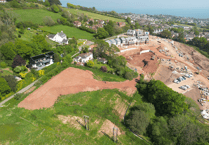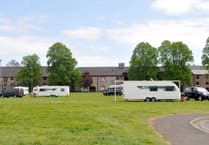How do search and rescuers operate on Dartmoor? I am about to find out.
It is a dark moonlit night and, having climbed aboard the Tavistock team’s Land Rover in Princetown, I am being driven down a track towards lonely Nun’s Cross Farm. In the driver’s seat is Alastair Reid, who is the Tavistock team’s recruitment officer. It is a Wednesday night, dry, cold and crisp. I have, inadvertently, chosen a good night to join the team for a practice exercise.
Everyone meets at 7pm at the Rendez Vous (RV), meeting place, not far from Nun’s Cross Farm. Here team members are already gathered in their kit and there is the crackle and buzz of the radio. Light shines from the doorway of the group’s control vehicle, on its last mission before being pensioned off (a new one is on the way, thanks to a recent £50,000 fundraising campaign).
I’m introduced to team member Guy Balmer, a former Royal Marine, my guide. He finds me some thicker gloves and a head torch and tells me a little more about what to expect.
Inside the control vehicle, search team managers Andy Wrayford and Paul Johnson are deciding where to send search parties, acting on intelligence as to the rough area where casualties, played by volunteers, will be found. Each practice night has a scenario, and tonight’s is that a photography lecturer called Carly has gone missing with two students. She has a broken ankle.
In the know about exactly where the casualty is, Guy takes me across uneven ground to the right spot where we can watch the rescue as it unfolds. The casualites are in a gully, one of those to be found on the moor which is all too easy to fall into when visibility is poor, or darkness falls suddenly.
Team member Andy Hodges from the bank above, as the first team arrive and their leader, Jane Hilton, takes charge; she sounds a horn to marshal the other teams to the spot. They discover that Carly, who will be eased onto a stretcher and taken back to base, is in fact not the worst injured; one of her companions is dangerously cold.
Andy explains: ‘We have one “big sick” and one “little sick”. The most important thing is to identify that the cold casualty is the higher priority than the noisy ankle casualty, which is a big distraction.’
He is put into a ‘group shelter’ which is a featherlight sheet of tent-like material wrapped around the casualty and tucked underneath them. ‘It works by stopping the wind chill and by trapping the air so you get warm in your own breath,’ explained Andy. ‘They are much better than the old fashioned survival bags, much more effective, because you can get two or three people in them and your combined heat is very effective.’
Ideally, he explained, casualties are ‘walked off the hill’. Occasionally, they are airlifted off by helicopter. Other times, as in tonight, they are taken by stretcher, a slow process over uneven ground, with callers in front of the stretcher guiding the rescuers back to base. The process of easing injured Carly onto a stretcher is a delicate one, still more so that of carrying the stretcher out of the gully.
It takes 30 rescuers, including the ones back at base, to bring these three casualties back.
Primary school teacher Carly Hodges, from Plympton, played the casualty with the broken ankle, roping in several friends who played the parts of the tothers.
Back at the rendez vous and unravelled from her wrappings – including something like a bean bag which moulds itself around the casualty to provide a support for broken bones – she said: ‘I didn’t know how I was going to feel, but I felt very safe, very secure. The communication was phenomenal, they were always talking to each other and talking to me.’
Rhod Davey, deputy team leader, is in charge on the night and has been responsible for coming up with the night’s scenario and running the rescue. He said: ‘I kept it relatively simple tonight to make sure that they were easy to find.’ The important test for the rescuers is to identify that the man who has become dangerously cold is more of a concern than the one with a broken ankle.
These days, rescuers have the benefit of the latest technology, including an app called SARLOC, developed by a mountain rescuer in another part of the country, which allows rescuers to locate missing people who have a mobile with them by sending them a text message. Nonetheless, rescues can still be protracted as my guide Guy explains. This could be where the rescuers are unconcious, so cannot give any indication of location. It could also be where they are not really seeking to be found.
‘We might have a specific grid reference given by the casualty or indeed a mobile phone SARLOC so we know exactly where the casualty is and go straight there as quickly as we can; we had one incident last year where within 20 minutes of us being called out by the police the first team members were at the site, so very quickly indeed. Another time though, we were on a search for a guy on New Year’s Day who left home, left a suicide note and was only found four days later, unforutantely dead.’
Many callouts are to search for ‘despondents’ as high risk missing people are known by the search and rescue teams, a particular issue in the dark days of the year.‘There is something about this time of year,’ says recruitment officer Alastair Reid. ‘People can go a bit odd’ While many rescues deal with minor injuries, the odd one stands out, where they really do save someone’s life. ‘You think thank God we were there’.
Dartmoor Search and Rescue Tavistock is a charity, one of four mountain rescue organisations which provide a 24/7 service on the moor.
The group are currently fundraising for an extension to their Tavistock HQ on Abbey Rise. all the rescuers are volunteers, with a new cohortsbeginning their training in January.Among the volunteers out on the night was member Pete Swaine. He explained as we walked te has turned his knowledge of the moor to the benefit of the charity, selling books of guided walks to raise funds for the group. The latest, featuring eight walks in the Meavy Valley, is on sale at:
dsrt-tavistock.org.uk/latest-news/





Comments
This article has no comments yet. Be the first to leave a comment.